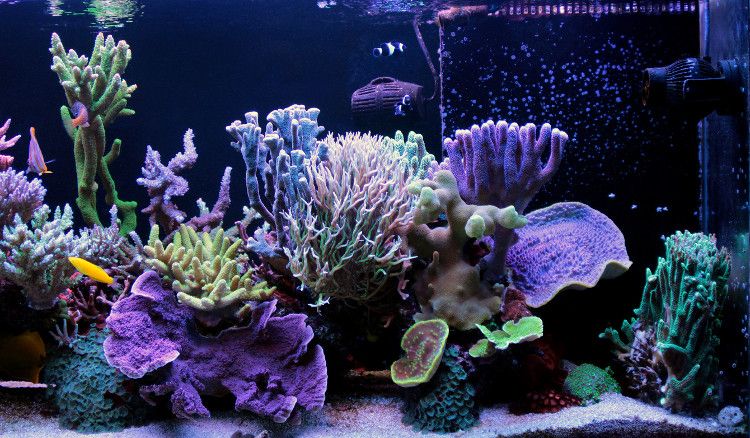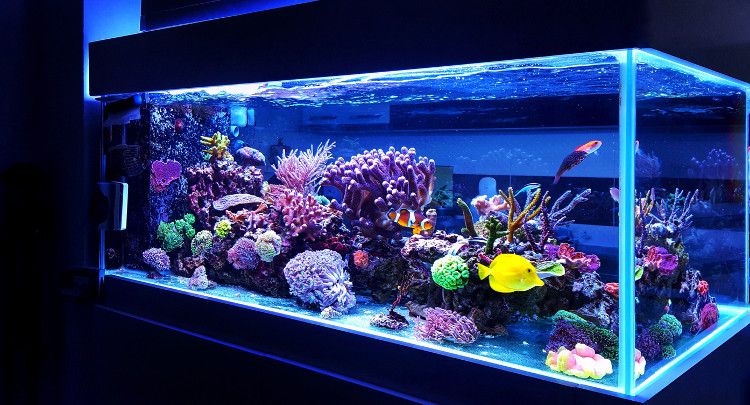Discover Everything You Need to Know About a Coral Aquarium
Eye-catching coral aquariums are riding a wave of popularity as more people take on the special challenges.
A coral aquarium requires more attention—and usually costs more—than a typical freshwater aquarium. The extra effort is worth it for many aquarists, however. Technological improvements and all-in-one setups also make the process simpler than in the past.

An array of vivid colors, textures, and shapes recreates a natural reef in this coral aquarium.
So, what can you expect? If you’re used to a freshwater aquarium, you’ll have to step up your game for a coral aquarium. You’ll keep close tabs on every aspect of your tank, checking water quality and temperature, nitrates, and phosphates, for instance. You need to be vigilant, because corals are generally more sensitive than fish to fluctuations in their environment.
Coral Varies in Growth Rate, Hardiness
Before you take the plunge, you should learn a little about coral. Coral falls into two major groups: hard coral and soft coral.
Hard coral creates a structure, or skeleton. These are the building blocks of coral reefs in the ocean. Soft coral has a more flowing appearance and may resemble a fan or tree. It attaches itself to rocks but does not develop its own hard structure.
Hard coral grows more slowly but can reach an impressive size. It is typically more sensitive than soft coral to changes in its environment. These changes may include water quality, water temperature, lighting, and nutrients. Soft corals, on the other hand, are likely to be more colorful and easier to keep.
What Kind of Coral Is Best?
Waiting for corals to grow can be a frustrating experience. Because of this, fast-growing types, such as zoanthids, are often a good option for beginners. Zoanthids are often called zoos or zoas. Another good choice is a vivid mushroom coral. This type is hardy and can handle temperature fluctuations well.
If you’re just learning about coral, ask the pros at Living Art Aquatics in Crystal Lake, IL, to share their wisdom about coral compatibility. Corals, like fish, don’t always play well together. The popular Frogspawn Coral, for instance, can reach out its tentacles to sting a neighbor up to 6 inches away. To keep the peace, give the aggressive corals a wide berth in your aquascape.
What Equipment Will I Need?
There’s less room for error with a coral aquarium. Get ready to open your wallet for specialized equipment to keep everything running smoothly.

Colorful fish explore the nooks and crannies of this stunning coral reef.
Lighting options
Corals vary in their need for light. Species found deep in the ocean will do best in darker waters, while those native to shallower, lighter waters will require more lighting.
You may be advised to use high-output lights for up to 12 hours a day. Sometimes lights raise the water temperature too much, however. Consider adding a water chiller to your shopping list if this happens.
LED aquarium lighting has become more popular as prices have fallen. These lights run cooler and are likely to last longer than traditional lighting.
Heaters
Getting the water temperature just right—and keeping it that way—is crucial. Too-cold water can harm your coral’s immune system. This adds to the risk of disease and death. If the water is too hot, on the other hand, oxygen is reduced. Oxygen-deprived fish may come to the surface to breathe.
You can place a backup heater in the tank, at a slightly lower temperature setting, as a preventive measure.
Pump
Water needs to turn over quickly in the tank to simulate the waves coral experiences in nature. Turbulence washes food to the coral and gets rid of sediment and mucus.
A special pump can ensure that water flows in more than one direction. Water moving in only one way could harm the coral.
Testing Kits
A coral aquarium requires more monitoring than freshwater tanks. You’ll test water salinity, for one thing. For hard coral, calcium content should also be checked. Supplemental calcium can be added as needed.
Testing kits designed to monitor multiple aspects of the tank environment can help you keep track of it all.
You may also find certain additional equipment, such as a UV sterilizer or a protein skimmer, to be useful.
Handle Coral with Care
Your coral aquarium may look pristine, but it’s best to wear gloves when you reach into the tank. This protects both you and your tank’s inhabitants.
Gloves protect from you from having any bacteria get into your body via a small cut or scrape. They also protect your tank. A bit of lotion or food residue on your hands could contaminate your coral.
One more benefit? You’re likely to cause less damage to fragile coral when wearing gloves. Aquarium gloves come in varying lengths and often have elastic on the forearm.
Interested in a Coral Aquarium?
The professionals at Living Art Aquatics in Crystal Lake, IL, in the Chicago area have been helping people create and maintain all types of aquariums for 20 years. They also offer aquarium maintenance services. Call (847) 737-5151 to get started on your own ocean adventure.






